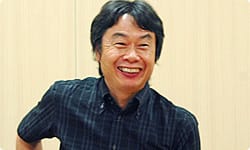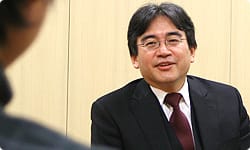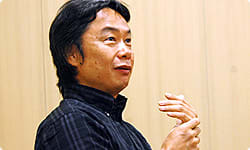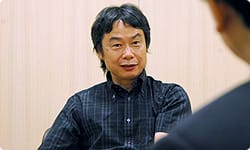The "Essence of Mario" Finally Put in Words
I felt that this was a very difficult project in the way you had participated.
You weren’t the director like in Mario 64, and even though you knew the staff in EAD Tokyo very well, it was about 400 kilometers (about 250 miles) away from Kyoto.
But I think I was able to work in a pleasant environment.
I don’t think we would have been able to make this game if I was the director, getting my feet wet in the development process, but I think it was possible because I was the producer. The development tools we were using were so much better than the ones we used in the past; the computer on my desk was always connected to Tokyo.
You were connected to them so much, that even in the mornings on days off, you were emailing them! (laughs)
They were constantly sending me the latest data, so I was able to respond to them immediately.
When I would go to Tokyo in the earlier stages of development,
I took over an entire room and had the development leads come in one by one, and we talked about the game while we were playing.
But then it struck me, "Is this something that I need to be doing all the way in Tokyo!?" (laughs) So I had the same environment created in one of the conference rooms in Kyoto, and I held meetings displaying the game screen using a camera, and talking about how we should change things in the game via video conferencing. So I was able to work as if I were in the Tokyo office.
Koizumi-san, the director, referred to you playing the game as if you were sampling their first dishes that they had created.
That situation was very strange. Everybody was staring at me, and I was very embarrassed! (laughs) Mario is the kind of game where you always have to focus. But if I were to not play well while everyone was watching, there’s no way that I could tell them, "Sorry, I wasn’t paying attention!" (laughs)
(laughs)
I was worried that they would say things in their heads like "Miyamoto-san talks an awful lot, but he can’t play at all!", and "That’s the best he could do?
I don’t want him telling me how to make games!", so I was playing as if I was walking on pins and needles! (laughs) But anyways, I tried all the different courses in front of everyone saying things like "The way you get beaten this easily at a point like this is not right."
I had told them what sort of things I can tolerate, and what things I cannot accept. I asked them to schematize what I had told them, and make them into shape.
You wanted to define the "Essence of Mario".
That’s right. I wrote these things in an email, and I sent them to everyone that was involved,
even if they didn’t directly relate to that part of the development.
That’s an very interesting way to do things.
I wanted to take those fundamental elements that were created at that time, and place it in our game building process. For example, when Mario would always travel from left to right in a 2D Mario game. In one out of the ten times that you go left, you’ll find a little prize. Everybody usually would think that they are supposed to go to the right, but we wanted to reward those people that decided to travel and investigate the other side. So we tried implementing these fundamental things in every course in the game, but the team would lose balance if everyone did that, so I used my email to maintain coordination between the staff.
During development, I remember you saying happily,
how the "Essence of Mario" was finally put in words.
(with a very relieved expression) It was really the first time.
I want to ask you, for more than 25 years of making Mario, is this really the first time!? (laughs)
Before this, when we were to decide on something I kept saying "It’s instinct", so I’m actually surprised myself! (laughs) For example, everyone thinks of a cute, cuddly character when they’re asked to think of a character called Mario.
The types of cute characters that seem like they would be living in the Mario world.
Because they believe that the characters should be that way, they have a set image in their mind of things like how the eyes should always be wide open.
But I don’t really draw my characters with really big, wide-open eyes. And when a new staff, who had that misconception about the way Mario characters should be, would come up and show me some sketches saying "Look, I drew some Mario characters", and they would look nothing like the Mario characters that I was thinking of. Lately, all the artists’ techniques have improved compared to the past, but their styles seem to look more and more uniformed.
There’s this pre-created template of a "well-drawn picture", and it seems like the younger artists’ styles are forming to that template.
They have technique, but they lack character.
I think it’s perfectly OK for Mario to be drawn in a cool way, and by that I don’t mean drawing him specifically to be cool, but I think it would work well if the overall design treatment turns out looking cool. So in the past, I have always tried to not design anything that looks childish, and I had changed the design depending on the games, but all this had never been put in words. And as I was thinking of the best way to explain this to people to get them to understand, I remembered an experience I once had when I was working on Mario Bros. (Gunpei) Yokoi-san9 had asked me, "What’s something that wouldn’t be able to move if you stepped on them?", and I replied, "Well, that’s a turtle".
From that point on, ideas began to continuously flow outwards, and we talked about things like "I think it would seem more natural if you’re able to step on the turtle." and "When you step on it, should its insides come out?" Um, this might get long . . .
| *9. | Gunpei Yokoi is the late Development Manager of Nintendo who had headed the team that created the Game & Watch, and the Game Boy. |
Please, continue! (laughs)
In the end, you were only able to knock over the turtle from the bottom, and were not actually able to step on them . . . In Mario Bros., when a turtle gets knocked over, they’ll start moving after a little while. The thing is, it’s hard to tell exactly how long it’s going to take them to get back up. You can see them twitching, but you’re not able to tell after how many of those twitches that they would get back on its feet. So, we decided to change this and make a rule that you could tell this timing visually. We made it so that after you step on a turtle, it would pop out of its shell, and the turtle would start moving again when it gets back inside the shell. The little turtle that popped out of its shell works as the timer, and we felt that this would be something that anybody would be able to tell.
I don’t think other people would have been able to imagine making the turtle pop out of its shell! (laughs)
But then I realized I had made a critical mistake. The turtle’s shell is a part of the turtle’s bones that has evolved, so we ended up telling things that were not true to the children . . .
Turtle shells do not come off! (laughs)
After that, in Super Mario Bros., we were now able to step on the turtles. But it would not be scary at all if Mario was able to step on all the turtles, so we made some that Mario would be able to step on. To distinguish these turtles, we decided that the best way to tell them apart would be to place spikes on their shells . . .
Motokura-san, the designer, was saying, "When in doubt, use spikes"! (laughs)
It looks like they remembered what I have been telling them! (laughs) Even with the Boos, they do a peek-a-boo. They’re very shy, so they would blush. Like in these ways, I think it’s very important to design these things so its function would be easily understood. If a designer is just vaguely told to make something unique, they wouldn’t know what to do. So for this game, since the fundamental elements of Mario is to express the form to follow the function, it would be best to keep creating unique ideas that would come from this element. Don’t you think this makes it easy to understand?
I do. How the design expressing the function, is something that I wasn’t able to realize until I had it explained to me.
I finally understood all this when I put it into words. Even with the DS and Wii, fundamentally,
it’s the same.
I see, I see.
When we were going to take a picture of the DS, I felt very strongly about having the stylus appear in those pictures.
There was the need to have the people who would be looking at it for the first time, to understand how to use it.
That’s also why pictures of the Wii Remote are taken with the hand holding it.
I even made a very blunt request asking them not to take pictures of the remote by itself. Although, it was only a year ago when I finally realized that my designs had been representing their functions, so it took a really long time! (laughs) Wait, it may not have even be a year ago! (laughs)




